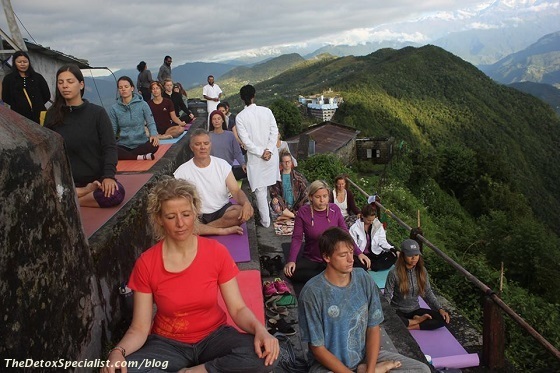
Summary: Through this blog, I would like to take the readers on a meditative journey of deep inner reflection that I personally have been on.
“Quiet the mind and the soul will speak.” — Ma Jaya Sati Bhagavati.
There was a time when the voices in my head won’t stop chattering. The constant inner monologue within my mind was slowly taking control of my life depriving me of the joys of the present moment. The negative and self-condemning thoughts filled my mind every now and then affecting my experience with myself and the world around.
Aimlessly browsing the web, I came across the various practices of Meditation and thought about giving it a try. Of course, at that point in time, I was ready to give anything a shot. I just wanted to feel happy and internally alive again. I decided to go ahead and learn about the science from a specialist. I packed my bags for Rishikesh, India and came under the spiritual guidance of a Guru who I would always remain indebted to all my life. He changed me and my life forever. In meditation, I found the courage and key to stop the fluctuations of the mind–the Chitta Vritti Nirodha for my own betterment and wellbeing. Here is what I discovered about this art.
When it comes to practicing meditation, most people are driven by misconceptions, prejudices, and false thinking. To some, it is next to impossible to sit for prolonged hours while to others, meditation translates to daydreaming or thinking. However, the reality is that Meditation (dhyana) is none of these.
Meditation (Dhyana) is a divine yogic technique of resting the mind in peace for attaining the state of consciousness different from the normal waking state. It is not a religion; it is a profound science of inward focus. Meditation is the practice of inner stillness for experiencing our essential self.
When I first started my meditation journey, I realized my mind is the biggest obstacle between me and the heightened awareness. But the dedicated practice of meditation helped me explore my inner dimensions, it taught me the expertise of calming the self, and to be focused in the present moment. Gradually, I fell in love with the science of meditation, with its power to reduce stress, and above all, its grandeur. I started exploring the vastness of meditation, its techniques, and slowly the diverse meditation practices became an inseparable part of my life.
- Breathing Meditation: Breathing meditation is my all-time savior technique. Simple and effective, it involves watching breaths while developing inner peace. As I devotedly practice the breathing meditation, there has been a gradual decrease in the distracting thoughts and an increase in the sense of relaxation. It is a powerful meditation technique for cultivating inner peace and contentment through the controlling of the mind.
How to Practice:
- Sit in a classical crossed legged position in a quiet place.
- Pay attention to your breath while breathing through the nostrils.
- Become aware of the sensations of the breath as you naturally inhale and exhale.
- Mindfulness Meditation: Mindfulness Meditation is the practice of savoring the present moment by bringing attention to the sensations within the body. It is the practice of simply observing every thought that passes the mind. The regular practices of mindfulness meditation have helped me remarkably in numerous ways: lower stress levels, restructuring the brain helping me form healthy habits and long-lasting positivity.
How to do:
- Begin in Easy Pose (sukhasana).
- Hands in Gyana Mudra on the knees and eyes closed.
- Breathe rhythmically and be aware of each breath.
- Completely focus on the breath to keep the mind centered.
- Mantra Meditation: OM is the divine sound that represents four states of the supreme being. Mantra Meditation is the practice of chanting the sacred ‘Om’ sound or any other mantra to bring the mind into a state of focused tranquility. Practitioners can recite ‘Om Mani Padme Hum,’ or ‘Ham-Sah,’ aloud or silently. The chanting of the sound “Om” creates positive vibrations in the atmosphere. It improves concentration and its vibrations benefit all those around. I personally recommend rubbing the hands and touching the body parts with the charged hands for healing.
How to Practice:
- Start in a seated position with an erect spine.
- Get comfortable and keep the eyes closed.
- Recite your mantra aloud.
- Continue for as long as you like.
- Vipassana Meditation: Vipassana Meditation in conjunction with the Samatha is the Buddhist practice of cultivating awareness and calming the formations of the mind. Vipassana means to see the things in the light of reality and truth. And, vipassana meditation is the route to develop higher consciousness in order to understand the truth. Quite difficult to adjust to in the beginning, Vipassana meditation helped me foster patience, unswayed perception, better memory, and liberation from the miseries.
How to Practice:
- Sit peacefully on a yoga mat.
- Pay attention to the movement of the abdomen as you breathe in and out.
- Keep the mind attentive to the process.
- Stay in this meditative pose for 30 seconds.
- Zen Meditation: Zen meditation is one of the powerful tools of personal transformation. A form of Buddhist meditation that benefits people in incredible ways. The practice helped me overcome my anxiety issues.
How to Practice:
- Sit upright with legs in a cross position.
- Keep the hands in cosmic mudra and eyes partially closed.
- Breathe through the nose and observe the breaths.
- Observe the thoughts flowing while sitting calmly.
I have been able to sustain my meditation practice for years now. And I have experienced mental and emotional expansion. I hope this would inspire you to practice meditation for experiencing the wonderful gift of life.
 Author Bio:- Bipin Baloni is a Yoga Teacher in Rishikesh India. His core specialization is in hatha and asthanga Yoga. He is a registered Yoga teacher who provides 200,300 and 500 hour yoga teacher training in rishikesh, India.
Author Bio:- Bipin Baloni is a Yoga Teacher in Rishikesh India. His core specialization is in hatha and asthanga Yoga. He is a registered Yoga teacher who provides 200,300 and 500 hour yoga teacher training in rishikesh, India.



